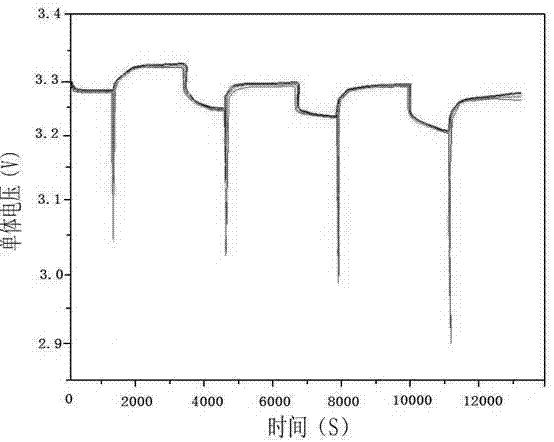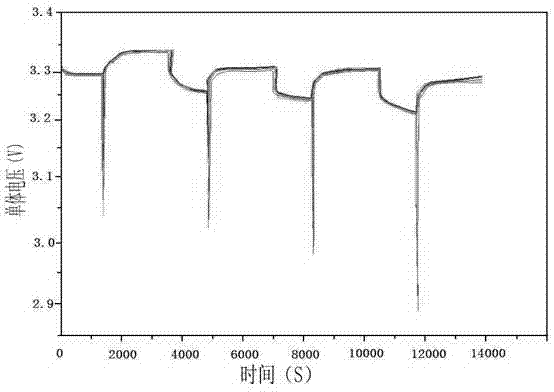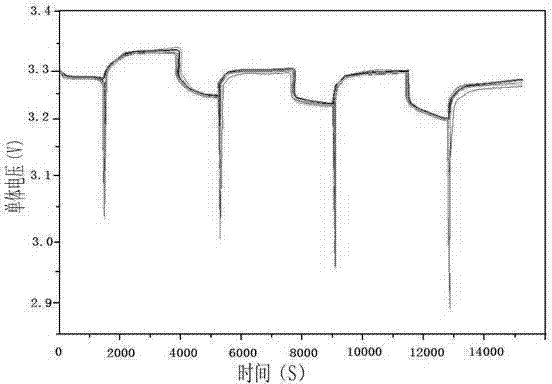Method used for rapid sorting of lithium ion batteries
A sorting technology for lithium-ion batteries, applied in secondary battery charging/discharging, secondary battery repair/maintenance, sorting, etc., can solve problems such as single sorting parameters, insufficient data accuracy, and increased sorting costs , to achieve the effect of simple operation, overall performance guarantee and cost saving
- Summary
- Abstract
- Description
- Claims
- Application Information
AI Technical Summary
Problems solved by technology
Method used
Image
Examples
Embodiment 1
[0028] A method for rapidly sorting lithium-ion batteries, comprising the following steps:
[0029] ①. Select 100 lithium-ion batteries with a rated capacity of 60Ah, use the chemical composition capacity detection cabinet to perform three charge-discharge cycles at a charge-discharge rate of 0.5C at room temperature, and finally set the SOC of the battery to 50%.
[0030] ②. Collect the discharge capacity, total charge capacity, constant current charge capacity, and constant current ratio (constant current ratio = constant current charge capacity / total charge capacity, counted by percentage) of each single lithium-ion battery during the third charge and discharge. .
[0031] ③. After the test, unload the lithium-ion battery from the capacity separation test cabinet, and place it at room temperature for 24 hours to ensure the stability of the battery.
[0032] ④. After standing still, use a voltage internal resistance tester to test the open circuit voltage and internal resis...
Embodiment 2
[0044] A method for rapidly sorting lithium-ion batteries, comprising the following steps:
[0045] ①. Select 100 power lithium-ion batteries with a rated capacity of 92Ah, use the chemical composition capacity detection cabinet to perform three charge-discharge cycles at a charge-discharge rate of 0.3C at room temperature, and finally set the SOC of the battery to 50% .
[0046]②. Collect the discharge capacity, total charge capacity, constant current charge capacity, and constant current ratio (constant current ratio = constant current charge capacity / total charge capacity, counted by percentage) of each single lithium-ion battery when it is charged and discharged for the third time .
[0047] ③. After the test, unload the lithium-ion battery from the composition and capacity testing cabinet, and place it at room temperature for 48 hours to ensure the stability of the battery.
[0048] ④. After standing still, use a voltage internal resistance tester to test the open circu...
Embodiment 3
[0060] ①. Select 100 power lithium-ion batteries with a rated capacity of 200Ah, use the chemical composition and capacity detection cabinet to perform charge and discharge cycles at a charge and discharge rate of 0.2C for 3 times at room temperature, and finally set the SOC of the battery to 50%.
[0061] ②. Collect the discharge capacity, total charge capacity, constant current charge capacity, and constant current ratio (constant current ratio = constant current charge capacity / total charge capacity, counted by percentage) of each single lithium-ion battery when it is charged and discharged for the third time .
[0062] ③. After the test, unload the lithium-ion battery from the composition and capacity testing cabinet, and place it at room temperature for 36 hours to ensure the stability of the battery.
[0063] ④. After standing still, use a voltage internal resistance tester to test the open circuit voltage and internal resistance of each single lithium-ion battery, and r...
PUM
 Login to View More
Login to View More Abstract
Description
Claims
Application Information
 Login to View More
Login to View More - R&D
- Intellectual Property
- Life Sciences
- Materials
- Tech Scout
- Unparalleled Data Quality
- Higher Quality Content
- 60% Fewer Hallucinations
Browse by: Latest US Patents, China's latest patents, Technical Efficacy Thesaurus, Application Domain, Technology Topic, Popular Technical Reports.
© 2025 PatSnap. All rights reserved.Legal|Privacy policy|Modern Slavery Act Transparency Statement|Sitemap|About US| Contact US: help@patsnap.com



